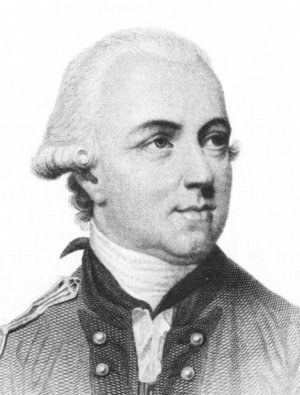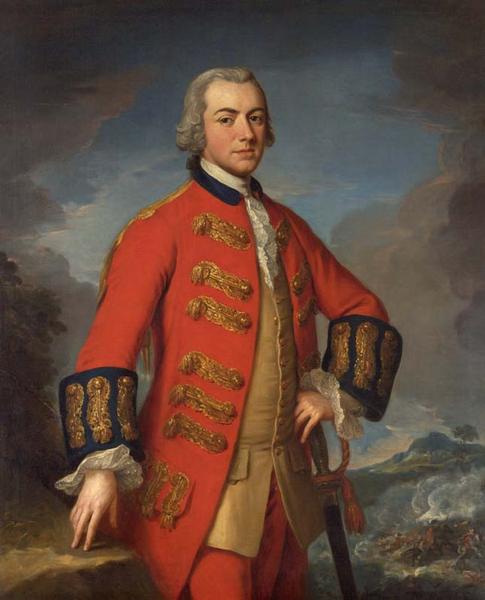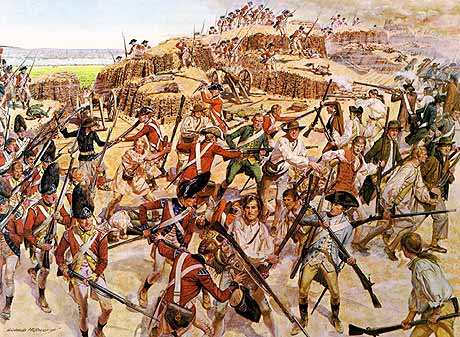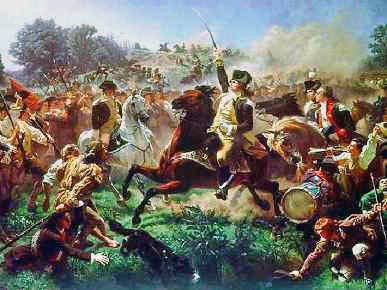General Sir Henry Clinton was a British General during the American Revolutionary War. After arriving in Boston three years previously, Clinton became British Commander-in-Chief in North America in 1778-1782. Following the war, Clinton returned to England and served in Parliament.
It is thought that Henry Clinton was born in 1730, but may have been born in 1738. His father was Admiral George Clinton and his mother was Anne Carle. It is thought that the exact date of his birth is April 16, 1780, though it may be wrong. Not much is known about Clinton’s life growing up. When George Clinton became Governor of the Province of New York and left in 1743, Henry Clinton accompanied him. George had tried to get his son a lieutenant’s commission, but twelve-year-old Henry was too young and went to New York instead. While there, Clinton most likely studied under Samuel Seabury, though it is not for sure if he did or not. After serving for a few years in New York, Clinton returned to England to join the military in Britain in 1749. Two years later he became a captain in the Goldstream Guards. With help from his father, Clinton was given a position in 1756 to aide Sir John Ligonier.
During the Seven Year’s War, Clinton had become a lieutenant colonel in the 1st Foot Guard in 1758. On July 30, 1760 the 2nd Battalion, 1st Foot Guards arrived in Bremen, Germany. That winter, Clinton was stationed at Paderborn. He was also with his unit during the Battle of Villinghausen in July of 1761. The following year on June 24th, Clinton and his unit also participated in the Battle of Wilhelmsthal and in cutting the French supply lines. By this time, Clinton had also been appointed to the rank of a colonel, though his regiment’s commander died at Elfershausen. Clinton had also been appointed as Prince Ferdinand’s aide-de-camp earlier. Clinton ended up badly wounded after the Battle of Nauheim that August when Prince Ferdinand has attacked Louis Joseph, Prince of Condé. The 1st Foot Guards returned to England after the Siege of Cassel. Throughout the war Clinton had established many long lasting friendships with other officers.
Harriet Carter, the daughter of a wealthy member of the gentry, and Henry Clinton married on February 12, 1767. Shortly after, they moved into a home located in Surrey. Six months later it is reported that their first child Frederick was born, though his exact date of birth is unknown. The couple had four other children together: Augusta (1768), William Henry (1769), Henry Jr. (1771), and Harriet (1772). Shortly after the birth of Harriet, Harriet Carter died on August 29, 1772. Clinton’s mother had also died that same month. There is no written account from Clinton on their marriage, but it was believed to be a very happy one, especially considering it took him over a year to recover from her death. After Harriet’s death, her sisters looked over the children for Henry. In 1774, Frederick died of illness.
Upon the start of the Siege of Boston in April of 1775, Clinton was sent with Major Generals William Howe and John Burgoyne to assist General Thomas Gage in Boston. The four of them worked together to create a plan to break the siege. Clinton supported the suggestion of fortifying high ground surrounding Boston that was unoccupied. On June 18, they planned to go through with the suggestions. Colonists had figured out what they wanted to do, and fortified Charleston Peninsula the day before. This left the British to have to rethink and plan their strategy to end the siege.
Major General Howe was put in command to directly assault the new fortification put up by colonists. However, his plans did not work, and after two assaults, Clinton went against orders given to him by General Gage. He went to Charleston and organized the wounded troops that were just milling and wandering about. Howe’s third attempt at assaulting the new fortifications finally succeeded. The British lost over 1,000 troops at the Battle of Bunker Hill, but still came out victorious. “A dear bought victory, another such would have ruined us,” is a famous line Clinton had written about the battle.
Clinton and Howe worked together when General Gage left Boston and Howe was put in charge, but the two quickly fell out. While Howe had put Clinton in charge of Charleston, Clinton rarely left Boston and didn’t put much effort into this command. He resided in the house of the famous politician John Hancock and had a housekeeper hired to keep the house in good condition. Him and his housekeeper, Mary Baddeley, had a platonic relationship while in Boston, and the two stayed close for the rest of their lives.
When Clinton was put in command for an expedition towards the south. He even asked howe to accompany him, but Howe refused, the two of them falling out even more so. Clinton left Boston to sail towards the south in January of 1776. Not long after, the British had to evacuate Boston in march and flee to Halifax, Nova Scotia.
A fleet sent from Europe was supposed to have arrived in the Carolinas to meet with Clinton that spring, but did not end up arriving until May, much later than expected. General Charles Cornwallis and Admiral Sir Peter Parker were both on the fleet, and joined Clinton upon the ship’s arrival. They quickly decided that it wouldn’t be smart to have a base in North Carolina, and moved to assault the unfished defenses in Charleston, South Carolina. However, their assault was not launched until late June and ended up failing.
After the failed attempt on Charleston, South Carolina, Clinton and Parker joined General Howe on his way to assault New York City in August of 1776. Howe only became angrier with Clinton because of his constant pestering and new ideas he wanted to share. Clinton suggested they attack the position in Brooklyn where George Washington was, and Howe decided to go through with that one. The two of them led British forces on August 27, 1776 at the Battle of Long Island, and won. Clinton continued to give Howe recommendations, but he only refused them.
Despite the fact the two were not getting along as well as before, Clinton stayed beside Howe and commanded the British forces at Landing at Kip’s Bay. Afterwards, Clinton led his army to Westchester County in hopes to capture George Washington while he was between the Hudson and Bronx rivers. But, Washington was already in Westchester County before Clinton reached it. He was able to push Washington and his men up farther north when they partook in the brief Battle of White Plains. Now, Howe and Clinton‘s relationship was worse than ever, and Howe refused to let Clinton go through any plans, no matter how small.
Howe then ordered for Clinton to prepare to go on an expedition so they could occupy Newport, Rhode Island. It was a coveted spot for the Royal Navy. Clinton proposed to Howe when General Cornwallis went to New Jersey to get rid of Washington that they occupy New Jersey instead of Rhode Island. In early December, Clinton set sail for Newport. When he reached the port, he was able to easily occupy it.
Following the occupation of Newport, Clinton was given leave from the army and told to return to England in January 1777. King George III refused to let Clinton resign, and he was sent back as Howe’s second in command in New York. On April 11, 1777 Clinton was invested in the Order of the Bath after previously becoming placated with a knighthood. He sailed for New York on April 29th.
Howe was in command of the Philadelphia command, but had still not left when Clinton arrived in New York. Instead of accompanying him, Clinton was left in New York to oversee the 7,000 British troops. Clinton felt as if he should not be given such a task, and told Howe that his plans for the Philadelphia campaign would not succeed. John Burgoyne was also headed off on a northern campaign. The campaign ended up failing, though Clinton had been supporting Burgoyne on his campaign.
The Battle of Forts Clinton and Montgomery was won by the British with Clinton in charge, and he gained both forts. He soon sent troops up towards Albany after the battle. Around the same time, the Philadelphia campaign had succeeded, but Howe wrote to Clinton in need of reinforcement. Many of Howe’s men had been badly wounded during the Battle of Germantown on October 4, 1777 and they had nearly suffered a defeat. Clinton stayed in New York now that he was in command of the city, and joined Mary Baddeley and her family. It is rumored that Clinton and Baddeley were having an affair during the time. When she realized her husband had been having an affair with another woman, Clinton attempted to get him transferred to another post outside of New York, but failed.
Following the 1777 campaigns, General Howe resigned from his post as Commander-in-Chief for North America. Clinton was one the list of men who may be able to replace him, and was appointed to the post on February 4, 1778. Prime Minister North particularly didn’t like and trust clinton, put still gave him the post anyways. Word of his appointment reached Clinton that April, and he took command of Philadelphia in May. France had also began assisting the Americans, and Clinton was forced to leave Philadelphia. 5,000 of his men were then sent to the Caribbean. The Continental Army was a much more of an advantage now that France was assisting them, and Clinton was given strict orders to strengthen only British areas in North America. He was no longer permitted to try and gain more land in the colonies.
Instead of going by sea, Clinton went against strict orders and moved his army to New York by land. Him and his troops were able to march to New York easily, without even one wagon being lost. On the way, they also fought at the Battle of Monmouth where the infamous Charles Lee was put in charge of American troops and retreated instead of attacking like he was supposed to. Upon arriving in the city, Clinton and Admiral Howe faced the problem of French ships just outside New York harbour. Admiral d’Estaing decided to sail for Newport, and Clinton sent troops up to Newport as well. Meanwhile, Admiral Howe had sailed off to accompany d’Estaing in Rhode Island. Clinton had his forces sent to raid communities in the area and organized troops to send to Florida. The troops attacked Georgia instead, and they were able to take Savannah on December of 1778 until January. Clinton also detached troops that were in the West Indies and they captured St. Lucia.
Two major raiding expeditions were ordered by Clinton for Connecticut and Chesapeake Bay. Clinton had given suggestions that he was awaiting approval on, but had very little support, even after he sent Lieutenant Duncan Drummond to argue on his side in England. He also sent a list of admirals he wanted to work with, but none of them were ever appointed to join Clinton. Reinforcements he hoped would aid him in attacking Washington arrived late, so his plans never went through. Clinton occupied Stony Point when the Americans said they did not want to. Many people were criticizing Clinton and his orders at this point in the war. He then issued the Philipsburg Proclamation on June 30, 1770 that led to many runaway slaves being enlisted in the British army.
Clinton was hoping to send an expedition against South Carolina, and began assembling one quickly. Him and 14,000 men sailed to Charleston from New York towards the end of 1779. They were able to siege Charleston by early 1780. Him and Admiral Arbuthnot worked together to force the city to surrender with its 5,000 troops. The two of them constantly argued, as they did not agree or work well together during the siege. Their feud would last until 1781, and Clinton also faced a falling out with Cornwallis.
Sir Guy Carleton was given the post of Commander-in-Chief in 1782 after the surrender of Cornwallis at Yorktown. Clinton returned back home to England. A year later, he published a book on the 1781 campaign in North America, putting all blame on Cornwallis. Until 1784, Clinton also served in Parliament. He was later elected in 1790. Not much is known on his life after the war, however. In October of 1793, Clinton was given the rank of full general, and was appointed Governor of Gibraltar the next July.
On December 23, 1795, sixty-five year old General Sir Henry Clinton died in London. He was just about to assume his post in Gibraltar before his death. Clinton was buried at St. George’s Chapel, Windsor.






